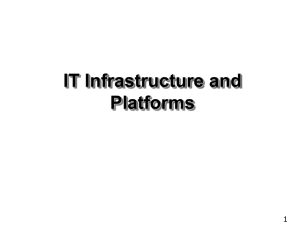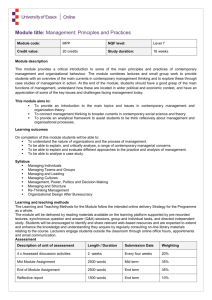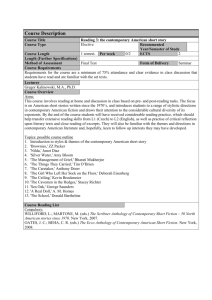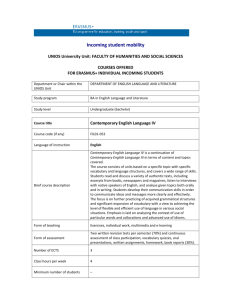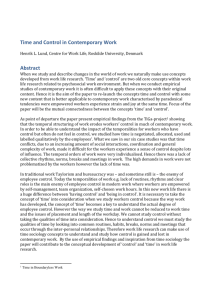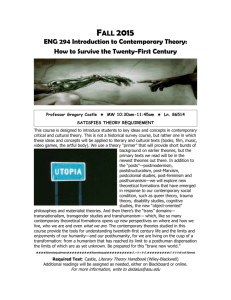IT Infrastructure
advertisement
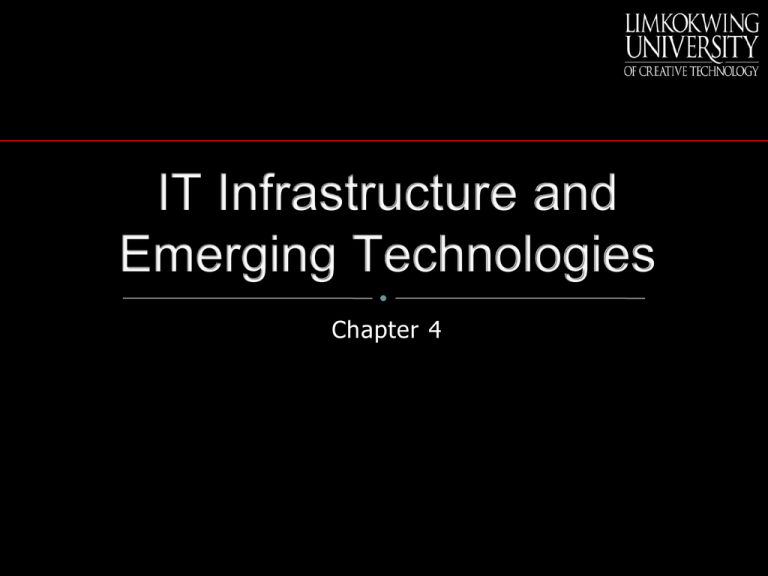
Chapter 4 OBJECTIVES • Define IT infrastructure and describe the components and levels of IT infrastructure • Identify and describe the stages of IT infrastructure evolution • Identify and describe the technology drivers of IT infrastructure evolution OBJECTIVES (Continued) • Assess contemporary computer hardware platform trends • Assess contemporary software platform trends • Evaluate the challenges of managing IT infrastructure and management solutions Hong Kong’s New World Telecommunications Case • Challenge: fragmented, high-cost IT • • • infrastructure slowed down market and customer response times Solutions: integrated storage area network to enable the flow of information among different types and brands of computer servers Reduce number of servers from 107 to 70 Illustrates the importance of IT infrastructure for achieving business objectives IT INFRASTRUCTURE Defining IT Infrastructure • Includes hardware, software, and services • A set of physical devices and software applications that are required to operate the entire enterprise • Your firm is largely dependent on its infrastructure for delivering services to customers, employees, and suppliers. • You can think of infrastructure as digital plumbing, but its much more than that! IT INFRASTRUCTURE The Connection between the Firm, IT Infrastructure, and Business Capabilities Figure 6-1 IT INFRASTRUCTURE Levels of IT Infrastructure Three major levels of infrastructure: • Public • Enterprise • Business unit IT INFRASTRUCTURE Levels of IT Infrastructure Figure 6-2 IT INFRASTRUCTURE Evolution of IT Infrastructure: 1950–2005 • Electronic accounting machine era: (1930–1950) • General-purpose mainframe and minicomputer era: (1959 to present) • Personal computer era: (1981 to present) • Client/server era: (1983 to present) • Enterprise internet computing era: (1992 to present) IT INFRASTRUCTURE Eras in IT Infrastructure Evolution Figure 6-3 IT INFRASTRUCTURE A Multitiered Client/Server Network (N-tier) Figure 6-4 IT INFRASTRUCTURE Technology Drivers of Infrastructure Evolution • Moore’s law and microprocessing power • The law of mass digital storage • Metcalfe’s law and network economics • Declining communications costs and the Internet • Standards and network effects IT INFRASTRUCTURE Moore’s Law and Microprocessor Performance Figure 6-5 Falling Cost of Chips IT INFRASTRUCTURE Figure 6-6 IT INFRASTRUCTURE The Capacity of Hard Disk Drives Grows Exponentially, 1980– 2004 Source: Authors. Figure 6-8 IT INFRASTRUCTURE The Cost of Storing Data Declines Exponentially,1950–2004 Source: “Exponential Growth an Illusion?: Response to Ilkka Tuomi,” by Ray Kurzweil, KurzweilAl.net, September 23, 2003. Used with permission. Figure 6-9 IT INFRASTRUCTURE Exponential Declines in Internet Communications Costs Source: Authors. Figure 6-10 INFRASTRUCTURE COMPONENTS Seven Key Infrastructure Components • Computer Hardware Platforms • Operating System Platforms • Enterprise Software Applications • Data Management and Storage INFRASTRUCTURE COMPONENTS Seven Key Infrastructure Components (Continued) • Networking/Telecommunications Platforms • Internet Platforms • Consulting and System Integration Services INFRASTRUCTURE COMPONENTS Computer Hardware Platforms • $110 billion annually spent in the United States • Dominance of Intel, AMD, and IBM 32-bit processor chips at the client level • Server market increasingly dominated by inexpensive generic processors from the same manufacturers INFRASTRUCTURE COMPONENTS Computer Hardware Platforms (Continued) • Strong server market growth for 64 bit generic processors from AMD, Intel and IBM • Blade servers replace box servers • Mainframes continue as a presence working as very large servers INFRASTRUCTURE COMPONENTS Operating System Platforms • $100 billion annually spent in the United States • Continued dominance of Microsoft OS in the client (95%) and handheld market (45%) • Growing dominance of Linux (UNIX) in the corporate server market (85%) • Windows 2002 and 2003 Server remains strong in smaller enterprises and workgroup networks INFRASTRUCTURE COMPONENTS Enterprise Software Applications • $165 billion annually spent in the United States for basic enterprise software infrastructure • SAP, Oracle, PeopleSoft (now Oracle), and Siebel dominate this market. • Middleware firms like BEA and JD Edwards serve smaller firms, and work also in the Web services space. INFRASTRUCTURE COMPONENTS Data Management and Storage • $70 billion annually spent in the United States. • Oracle and IBM continue to dominate the database software market. • Microsoft (SQL Server) and Sybase tend to serve smaller firms. • Open source Linux MySQL now supported by HP and most consulting firms as an inexpensive, powerful database used mostly in small to mid-size firms. INFRASTRUCTURE COMPONENTS Networking/Telecommunications Platforms • $150 billion annually spent on networking and telecommunications hardware • $700 billion annually spent on telecommunications services, e.g. phone and Internet connectivity • Local area networking still dominated by Microsoft Server (about 75%) but strong growth of Linux challenges this dominance INFRASTRUCTURE COMPONENTS Internet Platforms • $32 billion annually spent on Internet infrastructure in the United States • Internet hardware server market concentrated in Dell, HP, and IBM • Prices falling rapidly by up to 50% in a single year for low-power servers INFRASTRUCTURE COMPONENTS Internet Platforms (Continued) • Open-source Apache remains the dominant Web server software, followed by Microsoft’s IIS server. • Sun’s Java grows as the most widely used tool for interactive Web applications. • Microsoft and Sun settle a long-standing law suit and agree to support a common Java. INFRASTRUCTURE COMPONENTS Consulting and System Integration Services • Most firms today, even large firms, cannot develop their systems without significant outside help. • $130 billion annually spent on computer system design, and related business services like business process redesign in the United States • About 85% of business consulting in the United States involves IT business consulting. CONTEMPORARY HARDWARE PLATFORM TRENDS The Integration of Computing and Telecommunications Platforms • Increasingly computing takes place over the network. • Client level: integration of cell phones and PDAs (Example: Palm Treo) • Television, video, and radio move toward digital production. CONTEMPORARY SOFTWARE PLATFORM TRENDS The four major themes in contemporary software platform evolution: • Linux and open-source software • Java • Web services and service-oriented architecture • Software outsourcing CONTEMPORARY SOFTWARE PLATFORM TRENDS The Rise of Linux and Open-Source Software • Open-source software is free and can be modified by users. • Developed and maintained by a worldwide network of programmers and designers under the management of user communities CONTEMPORARY SOFTWARE PLATFORM TRENDS The Rise of Linux and Open-Source Software (Continued) • Linux is the most widely used open-source software program. Linux is an operating system derived from Unix. • Mozilla Firefox browser and Thunderbird mail clients are the most widely used open-source applications. Others include MySQL. • IBM, HP, Intel, Dell, and Sun have adopted and support Linux. Linux is a major alternative to Windows server and even client operating systems. CONTEMPORARY SOFTWARE PLATFORM TRENDS Java Is Everywhere Java: • An operating system—Independent, processorindependent, object-oriented programming language • Applications written in Java can run on any hardware for which a Java virtual machine has been defined. • Java is embedded in PDAs, cell phones, and browsers. • Java is a leading interactive programming environment for the Web. CONTEMPORARY SOFTWARE PLATFORM TRENDS Software for Enterprise Integration: • One of the most important software trends of the last decade is the growth of “enterprise in a box” or the purchase of enterprise-wide software systems by firms. • Rather than build all their own software on a custom basis, large firms increasingly purchase enterprise applications prewritten by specialized software firms like SAP, Oracle, PeopleSoft, and others. CONTEMPORARY SOFTWARE PLATFORM TRENDS Enterprise Application Integration (EAI) Software Versus Traditional Integration EAI software (a) creates a common platform through which all applications can freely communicate with each other. EAI requires much less programming than traditional point-to-point integration (b). Figure 6-13 CONTEMPORARY SOFTWARE PLATFORM TRENDS Web Services and Service-Oriented Architecture Web Services: • An alternative to enterprise systems is to use new Webbased standards to create a communication platform allowing older applications to communicate with newer applications. • Web services refers to a set of loosely coupled software components that exchange information with each other using Web communication standards and languages. CONTEMPORARY SOFTWARE PLATFORM TRENDS Service-Oriented Architecture • SOA refers to the use of Web services in a firm to achieve integration among disparate applications and platforms. • A firm might have applications (payroll) running on older AS400 IBM machines, IBM mainframes (customer data and inventory) and newer applications running on client/server networks. CONTEMPORARY SOFTWARE PLATFORM TRENDS Software Outsourcing • Today large and small firms purchase most of their software from outside vendors. Three kinds of outsourcing: • Purchase of software packages • Using application service providers • Custom outsourcing CONTEMPORARY SOFTWARE PLATFORM TRENDS Purchase of Software Packages and Enterprise Software Enterprise software packages: prewritten off-the-shelf software Application Service Providers: • A business that delivers and manages applications and computer services from remote computer centers to multiple users using the Internet or a private network MANAGEMENT OPPORTUNITIES, CHALLENGES, AND SOLUTIONS Competitive Forces Model for IT Infrastructure Thank you

